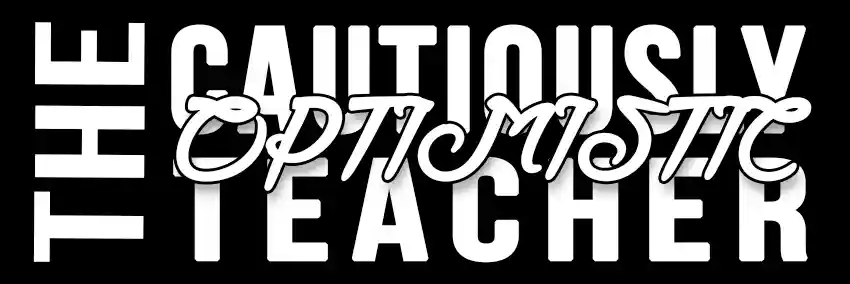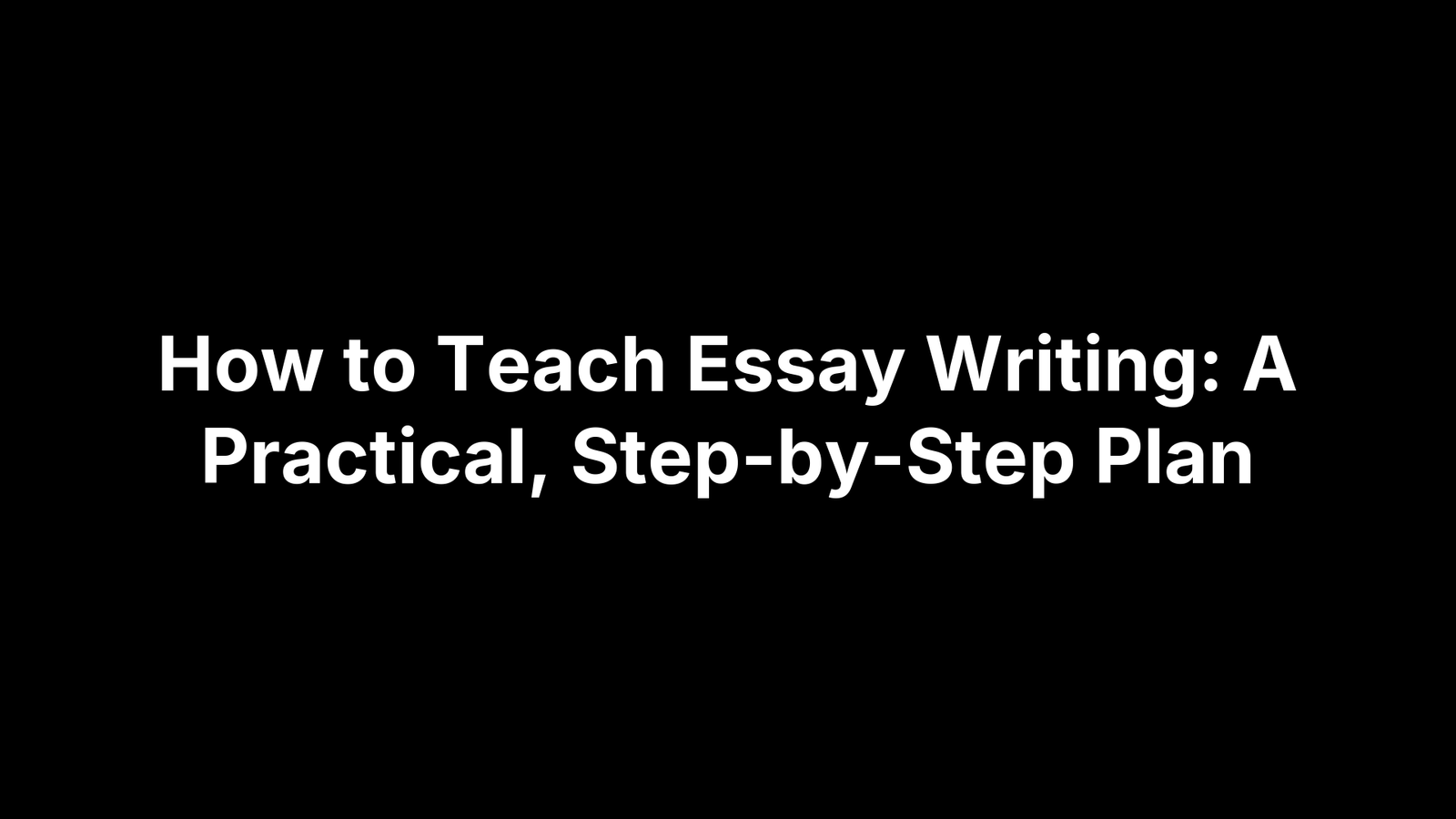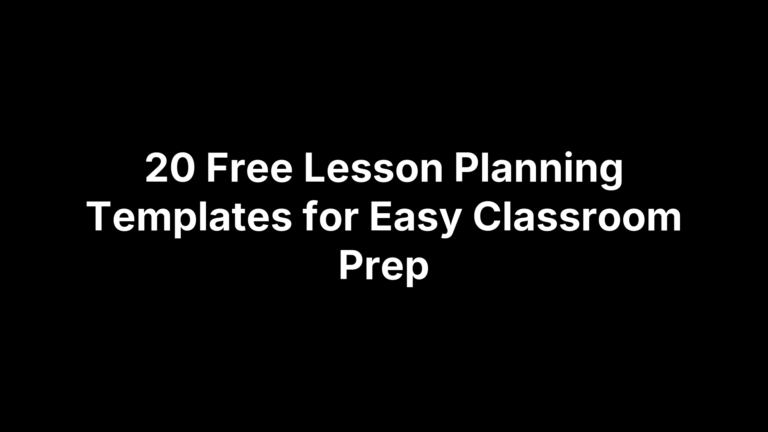How to Teach Essay Writing: A Practical, Step-by-Step Plan
If teaching essay writing feels like herding ideas, you’re not alone. Students stall at the blank page, race to fix commas before they have a claim, or hand you five paragraphs that don’t actually say anything. Meanwhile, you’re juggling pacing, standards, and grading piles without a shared language for what “good writing” looks like.
This guide gives you a clear, repeatable plan. It pairs a workshop routine with explicit mini-lessons, mentor texts, and the Six Traits of Writing so students know what to do at every stage—and why. You’ll see how to build background knowledge, model structure and craft, and scaffold from brainstorming to MLA formatting, with built‑in checkpoints that prevent plagiarism and lift the quality of ideas, not just the polish.
Here’s the path we’ll follow: clarify goals and genre; unpack the prompt and co‑create success criteria; map pacing and mini‑lessons; analyze mentor texts; build vocabulary; establish a shared Six Traits language; generate ideas; craft a thesis and blueprint; teach research and source evaluation; integrate evidence with citations; outline; draft each section (including counterclaims); revise for content and style; run peer review and conferences; edit and format; differentiate and use AI supports responsibly; assess with actionable feedback; and publish and reflect. Let’s start with sharpening the goal and essay type.
Step 1. Clarify the goal, essay type, and standards alignment
Before you launch mini-lessons, get crystal clear on what students must learn, what they will produce, and how you’ll judge success. The fastest way to teach the essay well—and to show students how to teach essay writing to themselves over time—is to name the target skill, pick the right genre, and anchor it to standards and the Six Traits focus.
- Define the learning goal: Prioritize Ideas and Organization (core middle school levers) with clear outcomes.
- Choose the essay type: Narrative, expository, or argumentative—match the prompt’s purpose and language.
- Specify product and audience: Length, MLA expectations, sources required, and who the reader is.
- Align to standards: Map objectives (thesis/claim, topic sentences, evidence, analysis, transitions, citation).
- Set assessment weights: Use a trait-aligned rubric that emphasizes Ideas/Organization over Conventions early.
- Write student-friendly success criteria: “I can…” statements that mirror the rubric for daily checkpoints.
Step 2. Unpack the prompt and co-construct success criteria (rubric and exemplars)
One of the fastest levers in how to teach essay writing is making the task unmistakably clear. Before a single sentence is drafted, unpack the prompt with students and co-create success criteria tied to the Six Traits so everyone knows what “good” looks and sounds like.
- Run a 10-minute prompt protocol: Box the task verbs (argue, explain, compare), underline the purpose/audience, and circle constraints (sources, POV, length, MLA). Translate this into a must/should/could checklist.
- Co-create trait-aligned “look-fors”: With students, define success for Ideas (clear claim + relevant reasons), Organization (hook, topic sentences tied to claim, transitions, purposeful conclusion), Voice (appropriate tone/person), Word Choice (precise, academic where needed), Sentence Fluency (varied, no run-ons/fragments), Conventions (punctuation, citation, formatting).
- Analyze exemplars together: Compare a strong and a developing sample. Highlight evidence of hook → context → thesis, signal phrases for evidence, explanation after quotes, and a conclusion that restates and calls to action.
- Build a simple, weighted rubric: Emphasize Ideas/Organization first; add brief codes for feedback (e.g., O2 = missing topic sentence, I3 = thin explanation) to streamline responses.
- Calibrate with a quick sort: In groups, sort anonymous samples into Exceeds/Meets/Developing and justify using the criteria; save them as anchor papers for drafting and revision.
Step 3. Map your workshop routine, mini-lessons, and pacing
A predictable workshop routine is the backbone of how to teach essay writing well. Keep the daily arc tight: model one move, give students long protected time to try it, and close with a quick share that feeds tomorrow’s goal. Anchor pacing to the Six Traits—front‑load Ideas and Organization—while threading the BLOCK sequence across weeks.
- Daily workshop (45–60 min): 8–10 min targeted mini-lesson → 25–35 min work time with conferences → 5–7 min share/exit ticket tied to success criteria.
- 4-week pacing (BLOCK + Traits):
- Week 1: Brainstorm/Layout—prompt unpack, mentor texts, graphic organizers, thesis + blueprint (Ideas/Organization).
- Week 2: Outline/Research—paragraph plans, source evaluation, notes, signal phrases, citation setup.
- Week 3: Construct—intro, body, counterclaim, transitions, sentence fluency and voice.
- Week 4: Kick it up—revision by Traits, peer review, edit conventions/MLA, publish.
- Built-in checkpoints: Thesis approval, outline check, evidence log with citations, first body paragraph check, conference roster.
- Mini-lesson menu: Hooks; claim vs. topic; topic sentence → evidence → explanation → link; quoting/paraphrasing with MLA; transition ladders; conclusion moves; revision strategies for word choice and fluency.
Step 4. Analyze mentor texts to model structure and craft
One of the most reliable moves in how to teach essay writing is to show, not tell. Short mentor texts—model essays, model paragraphs, even annotated excerpts—let students “read like writers,” naming the structural choices and craft moves they’ll imitate. Tie the analysis to the Six Traits so students see how Ideas and Organization lead, while Voice, Word Choice, Sentence Fluency, and Conventions refine the draft.
A quick mentor-text protocol
Keep this routine tight and consistent so students can transfer it to any genre. Project the text, think aloud once, then release the noticing to students before an immediate imitation write.
- Preview purpose and map structure: trace
hook → context → thesisandtopic sentence → evidence → explanation → link. - Mark evidence moves: underline
signal phrase + quote/paraphrase (MLA), highlight the explanation that follows, and circle transitions. - Name the craft in Trait language, then “steal the move”: write your own hook, a claim + blueprint, and one evidence-explanation sentence pair on the spot.
Step 5. Build background knowledge and academic vocabulary
When students don’t know the topic—or the language to discuss it—they default to filler. A quick investment in content knowledge and academic vocabulary pays off with stronger Ideas and clearer Organization. This is a quiet superpower in how to teach essay writing: give students something to say and the words to say it.
- Prime the schema: Curate a 10–15 minute “text set” (1 short article, 1 chart/infographic, 1 short video) and a 4–6 question anticipation guide to surface prior knowledge.
- Name the academic verbs: Pre-teach task words (argue, explain, compare), plus core terms (claim, thesis, counterclaim, evidence, citation, analysis).
- Use Frayer + morphology: Run Frayer models and quick morpheme talks (e.g.,
counter-,-tion,para-) to boost transfer and decoding of new terms. - Provide sentence frames: Bank stems for evidence and analysis: “According to…,” “This shows…,” “A counterargument is…,” “However, the evidence suggests…”
- Build a living word wall: Sort by function (Transitions, Hedging, Reporting Verbs) and require students to highlight 3–5 targeted words in drafts.
- Talk before write: 90-second pair shares using frames; capture key phrases on organizers to move from oral rehearsal to paragraphs.
Step 6. Establish a shared language with the six traits of writing
To make every lesson, conference, and rubric speak the same language, anchor your class in the Six Traits of Writing—VOICES. Teach and reference them in this order: Ideas, Organization, Voice, Word Choice, Sentence Fluency, Conventions. In middle school, emphasize Ideas and Organization first, then layer in the rest. This shared vocabulary is a cornerstone of how to teach essay writing with clarity and consistency.
- Make VOICES visible: Post an anchor chart with student-friendly definitions and examples; refer to it in every mini-lesson.
- Set trait targets daily: “Today we’re improving Organization: topic sentences that connect to the claim.”
- Tag models by trait: Annotate mentor sentences/paragraphs for the specific trait being studied.
- Use quick feedback codes: I2 = unclear claim; O2 = missing topic sentence; V1 = too informal; WC1 = vague word; SF1 = run-on; C1 = comma error.
- Revise by trait: Students highlight evidence of a target trait and write a one-sentence revision goal before drafting the next section.
Step 7. Generate ideas with low-stakes brainstorming and organizers
Drafts stall when students try to “sound academic” before they have something to say. Start with low‑stakes ideation that privileges Ideas and Voice—the B in the BLOCK method—so they can talk, jot, and sort without grading pressure. This is a pivotal move in how to teach essay writing: fill the page first, shape it later with a simple graphic organizer.
- Quickwrite sprints: 2×3 minutes on the prompt; highlight the strongest line.
- Mind map/topic web: Topic → reasons → concrete examples/evidence.
- T‑chart: Reasons vs. likely counterarguments to surface angles.
- 5W1H question storm: Who/What/When/Where/Why/How to deepen context.
- Sticky‑note sort: Cluster ideas into 2–3 categories and label potential paragraphs.
Step 8. Craft a clear thesis/claim and blueprint for reasons
This is the hinge move: convert scattered ideas into one precise sentence that answers the prompt and previews the paragraph plan. In how to teach essay writing, a thesis isn’t just an opinion—it’s the roadmap that drives Organization and keeps body paragraphs on track.
- Use a simple builder:
Claim + because + Reason 1, Reason 2, Reason 3- Argumentative:
X should/should not Y because A, B, and C. - Explanatory:
X occurs because A, B, and C. - Compare/Contrast:
While X and Y differ in A, they align in B and C, showing Z.
- Argumentative:
- Model a quick upgrade: Weak: “School uniforms are bad.” Strong: “Schools should not mandate uniforms because they suppress identity, burden families, and distract from real discipline.”
- Blueprint → paragraphs: Turn each reason into a topic sentence; arrange for impact (often strongest last).
- Run fast tests:
- Answer-the-prompt test: Does it take a clear position?
- Parallel check: Do topic sentences echo the blueprint words?
- So-what test: Is the claim debatable and specific?
- Voice/tone check: Use formal, third-person where required.
Step 9. Teach research and source evaluation; prevent plagiarism
A pivotal move in how to teach essay writing is giving students a simple research workflow that bakes in credibility checks and anti-plagiarism habits. Guide them to gather reliable sources, think critically about what they find, and capture citation details as they go. Keep it practical and repeatable so research strengthens Ideas and Organization rather than becoming a copy‑paste exercise.
- Plan the search: Generate keywords/synonyms; refine queries as understanding grows.
- Vet quickly: Check author/organization, date, purpose/bias, and supporting evidence; cross‑verify.
- Log as you go: Use a research/evidence log with columns for reason, source, note, and MLA details.
- Paraphrase safely: Read → cover → write from memory → compare → cite, even when paraphrasing.
- Define plagiarism clearly: Show examples of patchwriting/uncited borrowing; require a signed integrity statement.
Before drafting body paragraphs, require a thesis‑aligned evidence log and two vetted sources for a fast conference checkpoint.
Step 10. Integrate evidence with quoting, paraphrasing, and MLA in-text citations
Here’s where research turns into power. Teach a tight IICE routine—Introduce, Insert, Cite, Explain—so every piece of evidence strengthens Ideas and Organization. This move is central to how to teach essay writing that sounds authoritative without drifting into copy‑paste.
- Introduce with a signal phrase: “According to…,” “The report argues…,” using precise reporting verbs.
- Choose quote vs. paraphrase: Quote for definition/striking language; paraphrase to condense. Put exact words in quotation marks and keep the meaning faithful.
- Cite in MLA (author–page): Place a parenthetical right after the quote/paraphrase.
"(text)" (Smith 23)(Smith and Lee 45)(Smith et al. 12)("Short Title" 5)for no author
- Explain the evidence: 2–3 sentences that answer “So what?” Tie back to your reason/topic sentence.
- Use evidence signals: Blend with transitions and signal phrases to avoid “dropped” quotes.
- Always cite paraphrases: Credit ideas even when you reword.
Quick practice: write one “evidence sandwich”—context → quote/paraphrase + MLA → two sentences of explanation—then highlight the signal phrase, the citation, and the explanation in different colors.
Step 11. Outline the essay and scaffold paragraphs and transitions
Now convert the thesis and evidence log into a clear map. A tight outline keeps Organization front and center and makes drafting faster. In how to teach essay writing, this is the moment students lock in paragraph purpose, choose transitions, and plan where each quote/paraphrase (with MLA) will live.
- Use a one‑page outline: Introduction (Hook → Context → Thesis); Body 1–3 (Reason from blueprint); Counterclaim/Rebuttal; Conclusion (Restate → Review → Call‑to‑Action).
- Frame each body with TEEL + IICE: Topic sentence → Evidence (Introduce + Insert + Cite) → Explanation → Link back to claim.
- Assign evidence now: Under each reason, list the exact quote/paraphrase and the parenthetical citation that will follow it.
- Plan transitions by function:
- Sequence: First, Next, Finally
- Add/Emphasize: Moreover, Furthermore, Most importantly
- Contrast: However, Conversely, While
- Cause/Effect: Therefore, As a result, Consequently
- Sequence for impact: Arrange paragraphs (strongest last), and script forward‑looking links: “This financial burden also affects…”
- Quick outline checks: One clear reason per paragraph; topic sentences echo the blueprint; transitions fit purpose; every evidence item ties to the stated reason.
Step 12. Draft the introduction: hook, context, thesis
Strong introductions follow a simple, repeatable pattern students can master: hook, context, thesis. In how to teach essay writing effectively, keep the focus on Ideas and Organization—pull readers in, frame the issue, then state a precise claim with a blueprint. Model the pattern once, then have students write their own in real time using their outlines.
- Hook (1–2 sentences): Use a surprising statistic, brief anecdote, or provocative question connected to the prompt.
- Context (1–2 sentences): Define the issue, narrow the scope, and signal significance in neutral, concise language.
- Thesis with blueprint (1 sentence): Use
Claim because Reason 1, Reason 2, Reason 3(parallel wording = future topic sentences). - Voice and tone: Formal, precise, and assignment-appropriate; avoid “In this essay, I will…”
- Quality checks: Hook aligns with thesis, context is factual, claim is debatable/specific, and reasons match the outline.
Step 13. Draft body paragraphs: topic, evidence, analysis, link
Each body paragraph should prove one reason from the thesis and follow a repeatable frame so students stay focused on Ideas and Organization. A tight TEEL + IICE routine—Topic → Evidence (Introduce + Insert + Cite) → Explanation → Link—keeps writing clear and prevents “quote dumps.” This move is core to how to teach essay writing that’s coherent and persuasive.
- Topic sentence: Echo a blueprint reason with precise, parallel wording.
- Set up evidence: 1 sentence of context so the quote/paraphrase makes sense.
- Insert and cite: Use a signal phrase + quote/paraphrase + MLA
(Author page). - Explain the evidence: 2–3 sentences answering “So what?” and tying to the reason.
- Link/transition: Reconnect to the claim and point forward to the next idea.
Mini-skeleton to model:
T:Schools should not mandate uniforms because they burden families.E (IICE):According to the district’s 2024 survey, “uniform costs exceed $300 per year” (Lopez 7). This shows… Consequently…L:Therefore, the financial strain undermines equity, which leads to…
Quick checks (by Trait):
- Ideas: Evidence directly proves the reason; analysis is longer than the quote.
- Organization: Topic sentence mirrors the thesis; clear closing link.
- Sentence Fluency: Vary starters; combine short sentences; no run‑ons/fragments.
- Conventions: Quotation marks and MLA placement are correct; verbs agree.
Common fixes:
- Trim quotes to the essential phrase; paraphrase when you’re explaining.
- Never drop evidence—always introduce and explain it.
- Replace vague language (“stuff,” “things”) with precise academic terms.
- Maintain assignment-appropriate voice (often third person, formal).
Have students color‑code drafts (Topic=blue, Evidence=green, Analysis=yellow, Link=purple) to self-check structure before conferencing.
Step 14. Add counterclaims and rebuttals when appropriate
Addressing the “other side” strengthens credibility and sharpens Ideas and Organization. A simple move in how to teach essay writing is to first summarize a reasonable opposing view in neutral language, then rebut it with specific evidence and clear reasoning that reconnects to the claim. Keep the tone formal (often third person) and apply the same IICE routine—Introduce, Insert, Cite, Explain.
- Place it purposefully: As its own paragraph before the final body paragraph, or as a brief section inside the strongest body.
- State the counterclaim neutrally: “Some argue that…” + signal phrase + citation.
- Rebut with evidence: Use IICE with MLA to show why the counterclaim is insufficient or less important.
- Warrant the link back: Explain how your evidence better addresses the prompt; tie to the thesis.
- Use precise transitions: Although, while, despite, however, nevertheless.
- Avoid pitfalls: No sarcasm/loaded language, no straw men, and never omit citations for paraphrases.
Sentence frames: “While some contend X, recent findings show Y (Author 12), which means Z.” “Although [counterclaim], [evidence + reasoning]; therefore, [link to claim].”
Step 15. Draft the conclusion that synthesizes and looks forward
A strong conclusion doesn’t rehash—it synthesizes. It brings Ideas and Organization together by restating the claim in fresh language, weaving the reasons into one insight, and showing why the argument matters now. This simple pattern is a high‑yield move in how to teach essay writing because it’s repeatable across genres without adding new evidence.
- Restate the claim (new words): Echo the thesis without copying.
- Synthesize reasons: Combine the big ideas; don’t list them. Show how they connect.
- Answer “So what?”: Implication, consequence, or solution.
- Look forward: A clear call‑to‑action or closing insight; optionally echo the hook for closure.
Use this quick frame:
Restated claim + since/because + synthesized reasons. Therefore/As a result, so‑what/implication. Call‑to‑action/next step.
Sentence starters: “Ultimately,…,” “Taken together,…,” “Therefore,…,” “To ensure… we should….” Avoid new citations here; save evidence for the body.
Step 16. Revise for content and style: ideas, organization, voice, word choice, fluency
Revision is where drafts turn into essays. Teach a two-pass routine that mirrors the Six Traits: first strengthen Ideas and Organization, then refine Voice, Word Choice, and Sentence Fluency. This keeps “how to teach essay writing” focused on meaning before mechanics and gives students a repeatable system.
Pass 1—Content (Ideas/Organization):
- Reverse outline: Write the thesis and each topic sentence in the margin; check they match the blueprint.
- Evidence/Explanation check: For each paragraph, verify IICE and that explanation outweighs quoted words.
- Flow test: Add or revise transitions; reorder paragraphs for impact; delete off‑topic lines.
- Claim clarity: Sharpen the thesis; ensure every paragraph links back in its closing sentence.
Pass 2—Style (Voice/Word Choice/Fluency):
- Read aloud: Mark choppy/awkward spots; combine or split sentences to fix rhythm.
- Vary starts/lengths: No more than two consecutive sentences starting the same way.
- Upgrade verbs and nouns: Replace vague words; choose precise reporting verbs for evidence.
- Trim 10%: Cut filler and redundancy; keep tone assignment‑appropriate.
Use trait codes (I, O, V, WC, SF) to set one measurable goal per page and track progress.
Step 17. Run structured peer review and 1:1 conferences
Peer review works when it’s narrow, timed, and anchored to the same success criteria you’ve taught. Pair students strategically, give them one trait focus at a time, and capture next steps. Your 1:1 conferences then become short, high‑impact check‑ins that target the exact move each writer needs—this is where how to teach essay writing becomes how students learn to revise themselves.
- Setup (12–15 min round): Writer highlights thesis and topic sentences; partner reads silently, then gives feedback using the class rubric.
- Feedback frame: Glow (what works) → Grow (one fix) → Next move (具体 action).
- Trait focus menu:
- Ideas/Organization: Claim clarity, blueprint–topic sentence alignment, paragraph purpose.
- Evidence (IICE + MLA): Signal phrase, quote/paraphrase, citation, explanation > quote.
- Fluency/Voice: Varied starts/lengths; formal, assignment‑appropriate tone.
- Peer tools: Color‑code TEEL, circle transitions, margin codes (I, O, V, WC, SF, C).
- 1:1 conference (3–4 min): Student states goal (trait code) → you read 6–8 lines → ask 2 questions → agree on one revision task and deadline.
- Exit ticket: “By next class, I will revise X by doing Y.”
Step 18. Edit for conventions and MLA formatting; finalize works cited
This final pass targets Conventions and presentation so strong ideas aren’t undercut by avoidable errors. In how to teach essay writing, separate revision (meaning) from editing (correctness). Give students a short, repeatable checklist and require a one-to-one match between in‑text citations and the Works Cited.
- Set MLA format: 1" margins, double‑spaced, 12‑pt readable font, left aligned. Add header with last name and page number (
Lastname 1) and a centered, informative title. - Fix quotation mechanics: Use signal phrases; put commas/periods inside quotation marks; place the period after the parenthetical citation.
- Audit in‑text citations: Use author–page style consistently, and cite paraphrases as well as quotes.
- Finalize Works Cited: New page titled “Works Cited,” alphabetized by author, hanging indent, and complete entries. Ensure every in‑text citation has a matching entry—and no orphaned sources.
- Conventions sweep: Correct spelling, capitalization, comma use, fragments/run‑ons, and agreement. Read aloud to smooth choppy spots.
- Final spot checks: Thesis matches body; topic sentences align with the blueprint; formatting and page numbers run throughout.
Step 19. Differentiate and scaffold (ELL, IEP, advanced); use AI supports responsibly
Differentiation isn’t a different assignment—it’s different access to the same Six Traits goals. In how to teach essay writing well, keep the core moves (thesis, TEEL + IICE, MLA) but adjust input, volume, and support. Use AI as a scaffolded coach, not a ghostwriter, and require visible process artifacts.
- ELL scaffolds: Visual text sets; bilingual/glossary supports; translated directions; sentence frames for claims/evidence/analysis; oral rehearsal before writing; cloze mentor paragraphs; allow L1 brainstorming with English drafting; maintain TEEL with reduced length.
- IEP accommodations: Chunked checklists; teacher-provided outlines/graphic organizers; dictation/text-to-speech; confer-and-coach checkpoints; extended time; prioritize rubric traits; fewer sources with deeper explanation; multimodal evidence explanation (brief audio + written quote).
- Advanced extensions: Alternative structures (problem–solution, compare–contrast, synthesis); nuanced counterclaims; 3–5 vetted sources, including data/visuals; mentor-style imitation tasks; rhetorical devices; real audience publication.
- Responsible AI use: Use AI to brainstorm questions, generate topic webs, build sentence-starter/transition banks, vary sentence fluency, and check MLA patterns; never to draft body paragraphs. Require evidence logs, outlines, and drafts; disclose AI assistance; fact-check all outputs; paraphrase from memory and cite.
Step 20. Assess with trait-aligned rubrics and actionable feedback
Assessment should mirror the language and moves you’ve taught. Anchor your rubric to the Six Traits (VOICES), weight Ideas and Organization most heavily early in the unit, and judge student work against the same success criteria and anchor samples you analyzed together. This keeps grading transparent and turns assessment into instruction—a key lever in how to teach essay writing with consistency.
- Use a one-point, trait-aligned rubric: Name what meets the mark, then add two boxes: “Strength” and “Next step,” tied to a specific trait.
- Give coded, actionable comments: Use brief trait codes (I, O, V, WC, SF, C + numerals) plus a precise fix: “O2: Add a topic sentence that echoes your blueprint.”
- Feed forward, not backward: End comments with one required revision task and a deadline.
- Assess the process, too: Score thesis checks, evidence logs, and outlines to reward the work that drives quality drafts.
- Calibrate and batch: Grade a small stack for one trait first; periodically moderate with anchor papers to keep expectations consistent.
- Build student self-assessment: Require a rubric reflection (“My strongest trait is…, my next move is…”) submitted with the draft.
Step 21. Publish, celebrate, and reflect; plan for transfer
An authentic audience is the final nudge that makes careful Ideas and clean Organization feel worth it. In how to teach essay writing well, publication and celebration signal, “This work matters,” while reflection and transfer make the skills portable. Keep it simple, visible, and tied to the same VOICES language you’ve used all unit.
- Publish options: Class anthology (PDF or eBook), hallway gallery with QR codes, live read‑alouds, or letters/op‑eds to real stakeholders.
- Celebrate intentionally: Trait‑based shout‑outs (Best Hook, Clearest Claim, Sharpest Rebuttal), author notes, and a quick signing day of printed pieces.
- Reflect for growth: 150‑word author’s note naming strongest trait + next step; attach evidence log, outline, and one “before/after” revision snippet.
- Plan transfer: Build a pocket checklist (Thesis + Blueprint; TEEL + IICE; VOICES) and a one‑page template students carry to the next unit/content area.
- Archive exemplars: With permission, save 2–3 anchor papers at each level for future mentor text study.
Next steps
You now have a repeatable plan—from clarifying the goal to publishing work your students are proud of. Start with one class, one prompt, and one four‑week cycle. Keep the routine tight, teach one move a day, and let the Six Traits drive every model, conference, and revision.
- Post the workshop arc: Mini-lesson → work time → share; use it daily.
- Standardize tools: Hand out a one‑page Thesis + TEEL + IICE template.
- Lock checkpoints: Thesis approval, evidence log review, and a mid‑draft conference.
For ready-to-use organizers, unit plans, and time‑saving teacher tools, visit The Cautiously Optimistic Teacher and join the weekly roundup.







